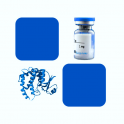
- Remove this product from my favorite's list.
- Add this product to my list of favorites.
Products
Newsletter
 |  |  |  |  |  |

Background
V-set and immunoglobulin domain containing 8 (VSIG8), also known as C1orf204, is a type I transmembrane protein of the B7 family within the Ig superfamily. VSIG8 was identified from proteomic analysis of human hair shafts. It is expressed in the hair follicle and shaft, superficial layers of the nail matrix, and superficial layers of oral epithelium.
Source
Recombinant Biotinylated Human VSIG8, Fc,Avitag (VS8-H82F2) is expressed from human 293 cells (HEK293). It contains AA Val 22 - Gly 263 (Accession # NP_001013683.1).
Predicted N-terminus: Val 22
Molecular Characterization
This protein carries a human IgG1 Fc tag at the C-terminus, followed by an Avi tag (Avitag™).
The protein has a calculated MW of 55.5 kDa. The protein migrates as 60-66 kDa under reducing (R) condition (SDS-PAGE) due to glycosylation.
Biotinylation
Biotinylation of this product is performed using Avitag™ technology. Briefly, the single lysine residue in the Avitag is enzymatically labeled with biotin.
Biotin:Protein Ratio
Passed as determined by the HABA assay / binding ELISA.
Endotoxin
Less than 1.0 EU per μg by the LAL method.
Purity
>95% as determined by SDS-PAGE.
Formulation
Lyophilized from 0.22 μm filtered solution in Tris with Glycine, Arginine and NaCl, pH7.5. Normally trehalose is added as protectant before lyophilization.
Reconstitution
Please see Certificate of Analysis for specific instructions.
For best performance, we strongly recommend you to follow the reconstitution protocol provided in the CoA.
Storage
For long term storage, the product should be stored at lyophilized state at -20°C or lower.
Please avoid repeated freeze-thaw cycles.
This product is stable after storage at:
-20°C to -70°C for 12 months in lyophilized state;
-70°C for 3 months under sterile conditions after reconstitution.
(1) "A small molecule inhibitor of VSIG-8 prevents its binding to VISTA"
Chen, Qie, Hu et al
Invest New Drugs (2022) 40 (4), 690-699
(2) "VSIG-3 as a ligand of VISTA inhibits human T-cell function"
Wang, Wu, Manick et al
Immunology (2019) 156 (1), 74-85
(3) "Comparative Transcriptome Analysis of Fetal Skin Reveals Key Genes Related to Hair Follicle Morphogenesis in Cashmere Goats"
Gao, Wang, Yan et al
PLoS One (2016) 11 (3), e0151118
Showing 1-2 of 4 papers.
Follow us